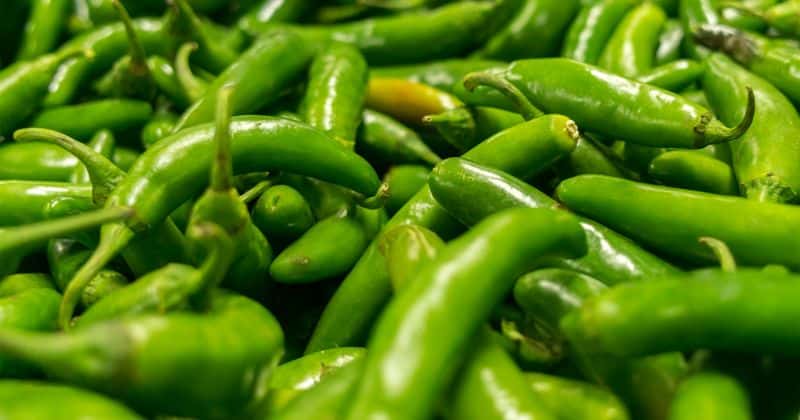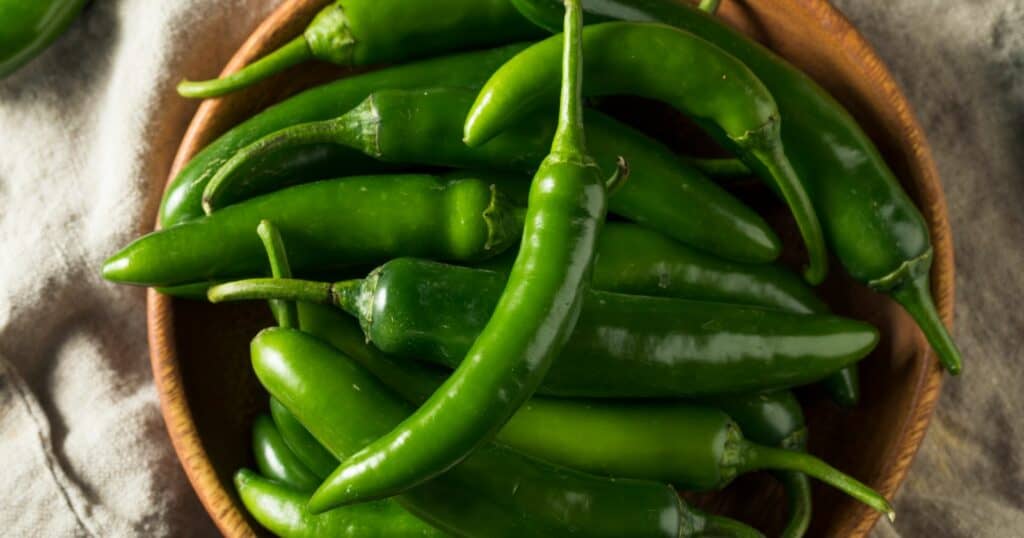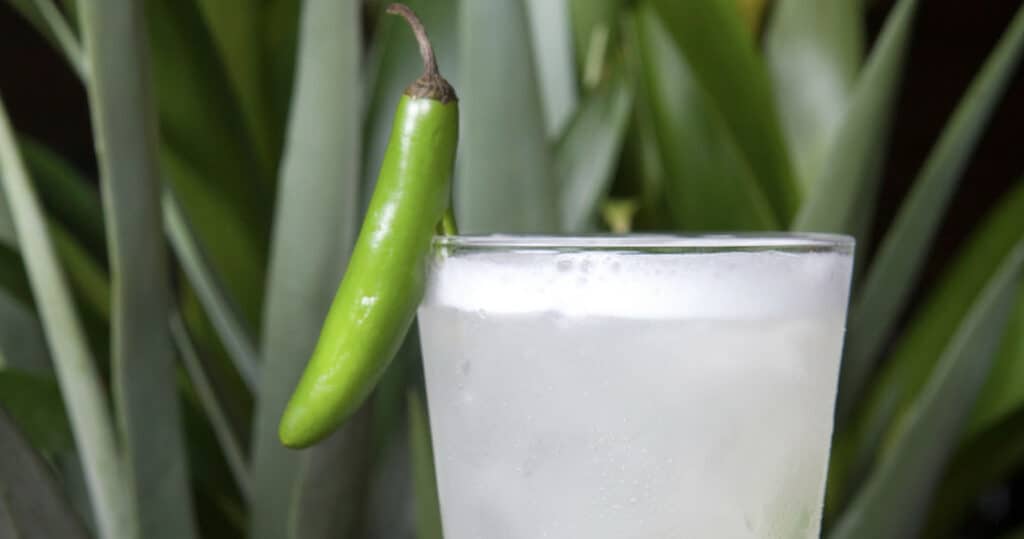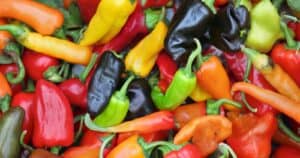Bright green serrano peppers add vibrant flavor to salsas, tacos, and more. But before you take a big juicy bite, ask yourself: Are serranos hot or mild?
If you can’t handle much
Here’s a quick look at serranos’ heat level:
- They rate 10,000 to 23,000 on the Scoville scale. That’s moderately spicy.
- Serranos are generally 3 times hotter than jalapeños. Expect some serious kick!
- But they aren’t nearly as fiery as habaneros or ghost peppers.
- Spiciness varies between individual peppers based on maturity, cultivar, and growing conditions.
With some preparation tips, even
- Use sparingly and add gradually to your taste.
- Remove hot seeds and membranes.
- Substitute milder peppers.
- Balance heat with cooling ingredients like dairy, starch, acids.
While serranos do pack some punch, their lively flavor is worth the ride. Keep reading to become a pro at handling their heat!
Serrano Scoville Units: Moderately Hot

The scoville scale measures the concentration of capsaicin, the compound that gives chili peppers their fire. The higher the scoville units (SHU), the hotter the pepper.
On average, serrano peppers rate around:
- 10,000 to 23,000 SHU
This places them firmly in the “moderately spicy” category. Serranos are much hotter than mild peppers like bell and pimento. But they don’t compare to the intense burn of habaneros or ghost peppers.
For reference, here’s how serranos stack up to other popular chili varieties:
- Jalapeños: 2,500 to 8,000 SHU
- Cayenne: 30,000 to 50,000 SHU
- Habanero: 100,000 to 350,000 SHU
As you can see, serranos are significantly spicier than jalapeños but tamer than cayenne peppers.
In general, most experts consider serranos about 3 times hotter than jalapeños.
Heat Varies Between Individual Peppers
Remember, the published scoville ratings are averages. The exact
- Serrano cultivars – Some varieties are bred to be hotter.
- Growing conditions – Altitude, climate and soil impact heat.
- Maturity – Serranos get hotter as they ripen from green to red.
- Natural variation – No two peppers are exactly alike.
So while 10,000 to 23,000 SHU is typical, individual serranos could be milder or spicier. Don’t assume they’re all equally hot.
To gauge heat, start with a small taste of any serrano before adding it to recipes.
Serrano vs. Jalapeño Heat Comparison
Since jalapeños are the most popular chili pepper, it’s useful to directly compare them to serranos:
- Most people find jalapeños have a mild to moderate heat. They can be eaten raw with just a tingle.
- Serranos pack a much punchier, more aggressive heat. Many find them too hot to eat raw – cooking mellows their
spice a bit. - At the lower end of the SHU range, some jalapeños are quite mild, while the hottest serranos will still have a good kick.
- On average, serranos should be about 3 times spicier than jalapeños, or roughly 10 times hotter based on their scoville units.
The best way to understand how you personally experience serrano vs. jalapeño heat is to taste them side by side. Start with a tiny sample of each at a similar scoville level.
You’ll quickly find out if serranos live up to their “much hotter” reputation for your preferences.
Handling Hot Serranos Safely

Don’t let serranos fool you with their waxy, innocent-looking skin. Those oils can cause:
- Skin irritation or burning
- Stinging blisters
- Severe irritation if you touch your eyes or face
Follow these safety tips when prepping serranos:
- Always wear gloves – capsaicin is hard to wash off bare skin.
- Avoid hand to face contact during cooking.
- Immediately apply oil then wash hands if irritation occurs.
- Remove seeds and membranes to reduce risk – that’s where the highest concentration of capsaicin hides.
- Thoroughly wash hands, utensils, and surfaces after prepping.
Strategies for Taming Serrano Heat
With some simple tricks, you can mellow serranos to suit your tastes:
- Remove seeds and inner membranes – they contain the most heat.
- Cut the pepper quantity by half – or add it gradually until the
spice level suits you. - Substitute milder jalapeños to significantly reduce heat.
- Use green unripe serranos for milder flavor – red ripe ones are spiciest.
- Roast or sauté briefly – cooking helps mellow their heat.
- Simmer in dishes with ample liquid – this dilutes the capsaicin oils.
- Balance with creamy, starchy foods like yogurt, beans, rice.
- Let sweet or acidic ingredients help temper the burn.
Start with small amounts and adjust until serrano heat hits your personal sweet spot.
What To Do With Serrano Peppers
Serrano peppers add delicious heat and flavor to many dishes. Their versatility makes them useful in a wide range of recipes. Here are some great ways to put serranos to work:
Salsas
Chopped serranos are perfect for fresh tomato salsa and pico de gallo. Add as much as you dare based on your
Sauces
Blend serranos into green or red enchilada sauce. Simmer into chili con carne. Puree into hot sauce. Their flavor stands up well to long cooking. Just tweak your recipe based on desired heat level.
Tacos
Slice fresh serranos to top carnitas, fish, or chicken tacos. Or add to fillings like shredded pork, beans, or peppers. Their crunch and
Jams and Jellies
COOK WITH CAUTION: Only use Serranos with proper ventilation – capsaicin vapor is dangerous to inhale.
Mince serranos (seeds removed) and cook into sweet jams or jellies. Pair with BBQ, chicken, or creamy cheeses. The contrast of sweet and heat is addictive.
Eggs
Chop serranos into scrambled egg fillings along with cheese, veggies, and more. Their
Marinades and Rubs
Blend serranos with lime juice, garlic, and cumin to marinate chicken or steak. The tender meat absorbs delicious flavor. Or add ground serranos to dry rubs for a kick of heat.
Cocktails

- Muddle serrano slices (seeds removed) into margaritas or bloody marys.
- Make a spicy serrano tequila by infusing tequila with sliced serranos for a few hours.
- Rim glass with serrano-salt blend. Mix salt with minced dried serranos.
- Use very sparingly! The heat intensified when cocktails are alcoholic.
Soups and Stews
- Add diced serranos to chicken tortilla soup.
- Put whole peppers into simmering vegetable or black bean stew.
- Stir chopped serranos into creamy potato soup.
- Simmering mellows their heat – adjust amount to taste.
Salads and Bowls
- Thinly slice raw serranos over green salads. Bright heat pairs nicely with dressing.
- Mix diced grilled serranos into summer grain bowls.
- Toss chopped serranos into fresh pico de gallo. Spoon over taco salads.
- Acids help tame heat. Add serranos slowly.
Seafood
- Stuff halved serranos with shrimp or whitefish salad.
- Mix diced serranos into tuna or salmon patties and cakes.
- Skewer shrimp and vegetables with serrano slices. Grill or broil.
- Chile heat pairs wonderfully with lighter seafood.
With their versatility, serranos can
Serrano Pepper Substitutes
Can’t find serrano peppers or want to dial down the heat? You have options! Here are some milder subs to use instead:
Jalapeño Peppers
Jalapeños are the most direct serrano substitute. They’re moderately spicy with a similar fresh, grassy flavor. For same amount of heat, use 1.5 to 2 times as many jalapeños.
Poblano Peppers
Poblanos are even milder than jalapeños with a richer, almost sweet flavor. Use about 2-3 times as many poblanos to match serrano’s heat level.
Anaheim Peppers
With only a mild kick, anaheims make a good substitute in terms of size and fleshiness. Use 3-4 times as many for a comparable heat level to serranos.
Hungarian Wax Peppers
Wax peppers offer moderate
Fresno Chilis
Fresnos bring mild heat and lots of red chili flavor. Swap 1:1 for serranos but expect a tamer
Pickled Peppers
Use pickled versions like pickled jalapeños or banana peppers. They’ll have milder heat but similar tang.
Ground Cayenne
Replace serranos with small amounts of cayenne pepper flakes or powder. Use 1/4 as much for similar heat. Cayenne has less flavor complexity.
Bell Peppers
For zero
Experiment with combinations like half serrano + half bell pepper. This lets you reduce heat while adding texture.
In Summary: Moderately Spicy and Delicious
While hotter than jalapeños, serrano peppers aren’t excessively fiery for most palates. Their average scoville rating lands in the moderately spicy zone.
But remember, individual serranos can vary greatly in their heat depending on maturity, cultivar traits, and growing conditions. Taste a tiny bite first to gauge their zing.
With proper precautions and cooking techniques, serranos offer the perfect amount of punch and chili flavor to enliven salsa, tacos, stir-fries, and other dishes.
Their lively heat adds dimension that makes recipes truly sing. Just take it slow with serranos until you learn your tolerance.
Once you grow accustomed to the burn, the delicious fruity flavor will have you coming back for more!
Frequently Asked Questions About Serrano Heat
Handling hot serrano peppers for the first time? Here are answers to common questions on managing their spicy bite.
Why are some serrano peppers hotter than others?
There are a few reasons individual serranos vary in their heat:
- Maturity – Green unripe peppers are milder. Red ripe ones are spiciest.
- Cultivar – Some serrano varieties naturally produce more capsaicin.
- Growing methods – Organic soil, hot climates, and dry conditions increase
spice . - Plant genetics – All chili plants aren’t created equal. Some just produce hotter fruit.
- Size – Smaller serranos tend to have more concentrated heat.
So don’t assume all serranos or even all peppers on the same plant are equally hot. Heat can range quite a bit.
Can I use serranos if I don’t like very spicy food?
Definitely! Adjust these tips to the recipe:
- Use fewer serranos than called for.
- Swap in milder peppers like jalapeños.
- Remove spicy seeds and membranes.
- Cook serranos to mellow heat.
- Balance with cooling dairy, starch, or sweet ingredients.
With some simple modifications, you can enjoy serranos’ flavor without excessive
How do you know if a serrano will be hot before you use it?
It’s hard to judge a serrano’s heat level just by looking. However:
- Smelling indicates pungency – stronger aroma means more heat.
- Red and orange serranos tend to be hotter than green.
- Smaller peppers are often spicier than larger ones.
For an accurate heat reading, taste a tiny piece of the pepper before cooking. Then you’ll know exactly what you’re dealing with.
What’s better for preventing chili burn – milk or yogurt?
Both dairy products can help neutralize capsaicin heat thanks to their fat and casein protein. Very cold whole milk provides fast relief if you need it immediately.
But thicker, richer yogurt or Greek yogurt adheres better and keeps working after you wash it off. So for long-lasting relief, yogurt may work best.
How long does the burning last after eating a serrano?
Most people feel the heat immediately, but it peaks around 5-10 minutes after consuming. It may take 15-30 minutes for the burning sensation to fully subside.
Capsaicin binds to pain receptors – drinking milk helps detach it faster. Be sure to avoid touching sensitive skin or eyes during this time.
For most palates, serranos bring manageable medium heat. With proper handling, you can safely enjoy their zing!





